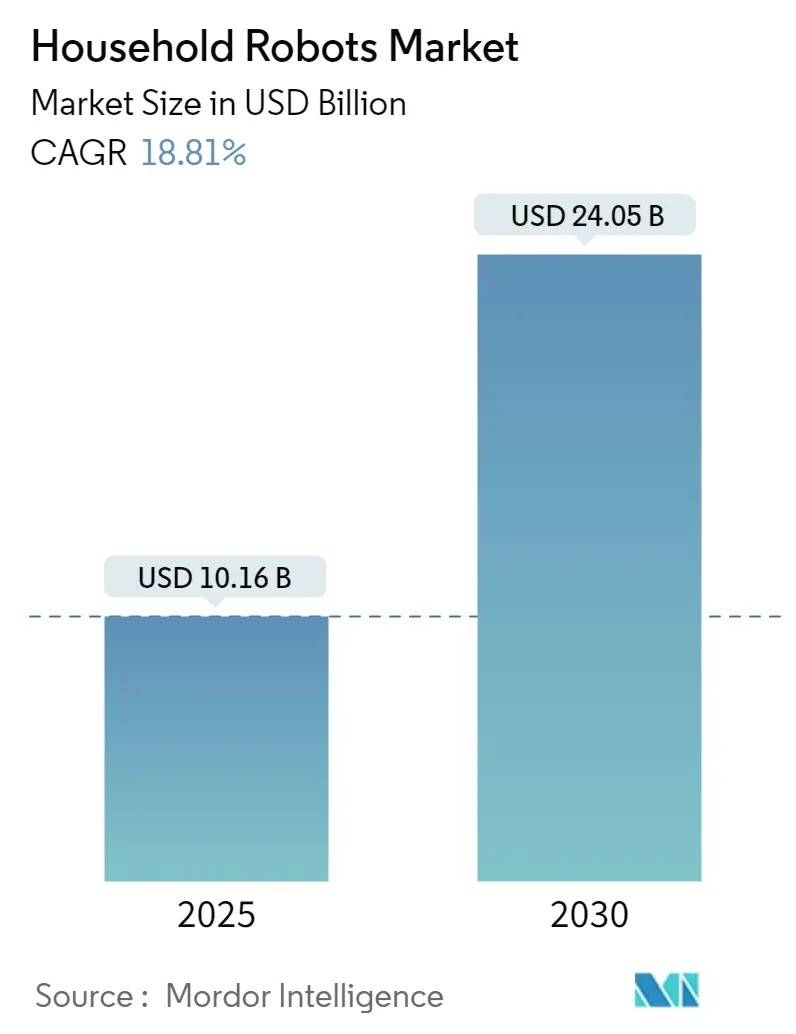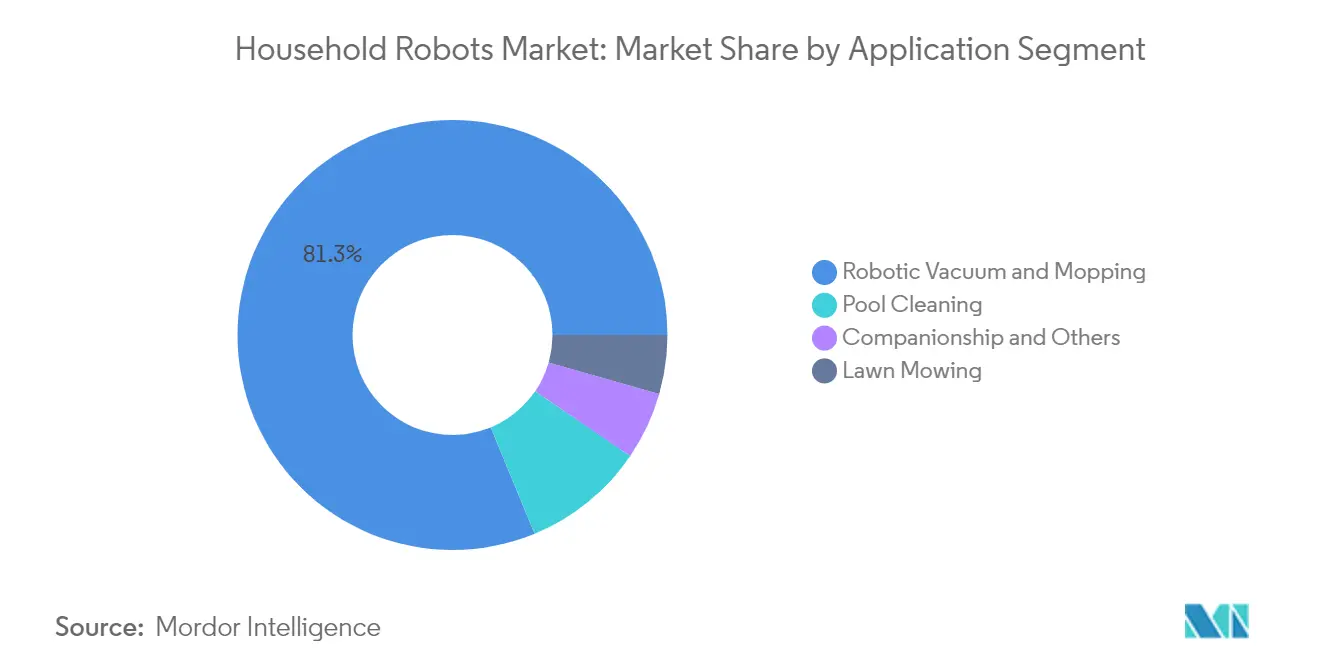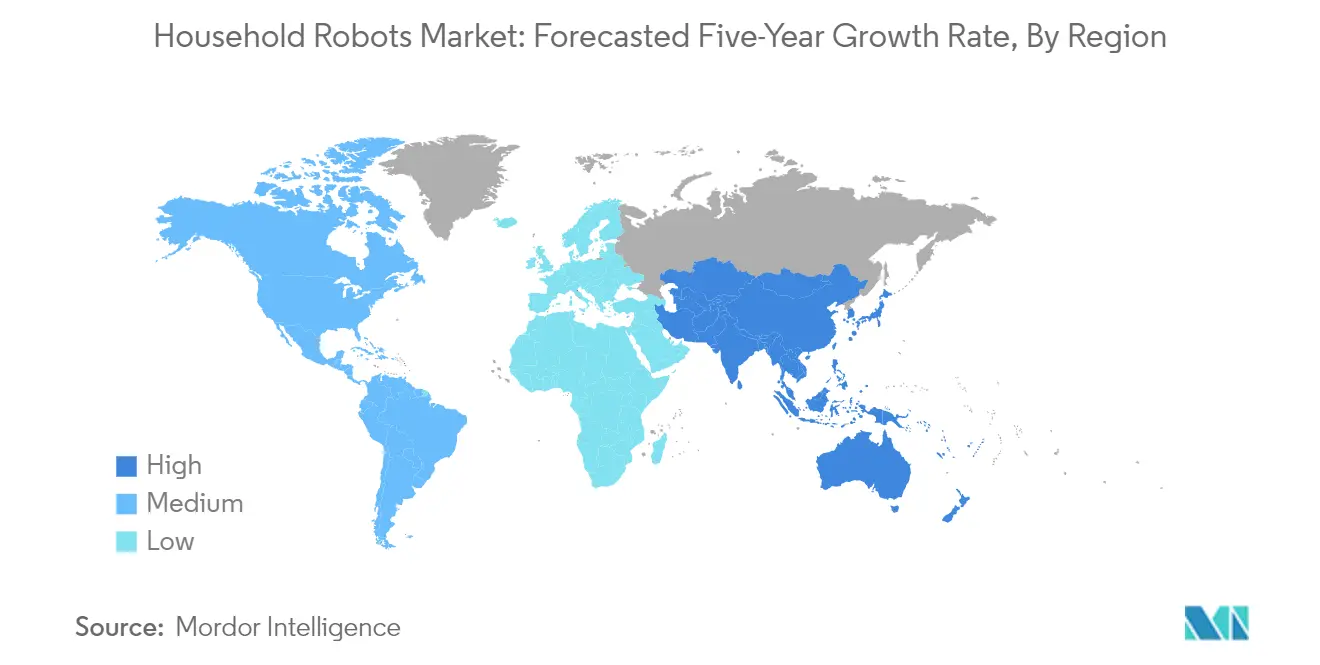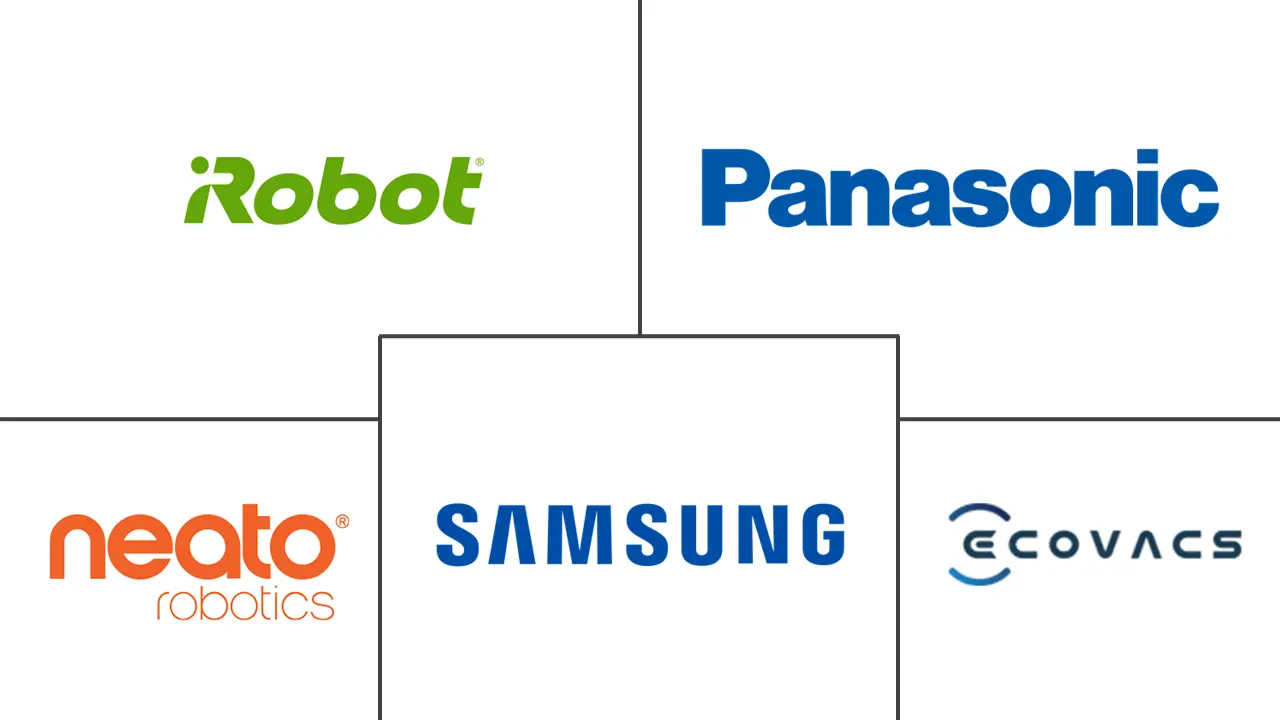Household Robots Market Size and Share

Household Robots Market Analysis by Mordor Intelligence
The Household Robots Market size is estimated at USD 10.16 billion in 2025, and is expected to reach USD 24.05 billion by 2030, at a CAGR of 18.81% during the forecast period (2025-2030).
The household robotics industry is experiencing a transformative phase driven by technological convergence and changing consumer preferences. Companies are making substantial investments in research and development, with Samsung announcing a KRW 240 trillion investment in future technologies over three years, demonstrating the industry's commitment to innovation. The integration of artificial intelligence, machine vision cameras, and advanced mapping technologies has revolutionized how household robots navigate and interact within domestic environments. These technological advancements have enabled domestic robots to effectively map floor edges, recognize obstacles, and make informed decisions in real-time, marking a significant evolution from their earlier, more basic functionalities.
The industry is witnessing a notable shift toward specialized applications and enhanced capabilities, particularly in elderly care and assistance. In March 2023, the Olympic Area Agency on Aging (O3A) and Intuition Robotics launched a groundbreaking program to provide ElliQ, an AI-driven care companion robot, to older adults in Grays Harbor and Pacific Counties. This development reflects the growing trend of using service robots technology to address specific societal needs. The integration of voice recognition, laser-based technologies, and intelligent mapping techniques has become increasingly common, with manufacturers focusing on creating more intuitive and user-friendly interfaces.
The market is experiencing significant developments in product innovation and manufacturing capabilities. In May 2022, Dyson revealed a prototype of home robots capable of performing domestic chores and announced plans to construct the UK's largest robotics research facility. This development signifies the industry's movement toward more sophisticated and capable domestic robots. The emergence of cloud-connected robots and their integration with smart home robots ecosystems has created new possibilities for remote control and management of household tasks, leading to increased adoption among tech-savvy consumers.
Cost considerations continue to shape market dynamics, with a notable shift in the economic proposition of household robots. According to the US Bureau of Labor Statistics, while cleaning labor costs approximately USD 27,000 annually, a cleaning robot represents a one-time investment of around USD 25,000, highlighting the long-term cost advantages of robotic solutions. The industry is witnessing increased competition among manufacturers, leading to innovations in manufacturing processes and gradual price reductions. However, the market still faces challenges in achieving mass-market penetration, particularly in developing regions where technological literacy and infrastructure limitations persist.
Global Household Robots Market Trends and Insights
Growing Research and Development Investments and Wide Range of Applications
The household robots market is experiencing substantial growth in research and development investments, with companies continuously introducing innovative technologies and expanding application areas. Major technology companies are making significant investments in developing advanced household robots, as exemplified by Samsung's announcement to invest KRW 240 trillion in future technologies over three years, with a dedicated robot business team established to promote the commercialization of home robots. These investments are driving innovations in various applications, from basic cleaning tasks to sophisticated companion robots roles, with companies integrating advanced technologies such as artificial intelligence, computer vision, natural language processing, and gesture controls to enhance robot capabilities.
The expanding range of applications is evident in recent product launches and technological advancements. For instance, in January 2023, Philips launched the R6 Slim cleaning robot vacuum cleaner with advanced features including a 2,700 pa suction power, multiple brushes for debris capture, and dual mop heads capable of rotating up to 120 times per minute. Companies are also developing service robots for specialized applications such as lawn maintenance, pool cleaning, and elderly care assistance. The development of social robots and companion robots has opened new avenues, with devices capable of providing emotional support, entertainment, and basic healthcare monitoring, demonstrating the versatility and growing sophistication of household robotics technology.
Rapid Urbanization
Rapid urbanization is emerging as a significant driver for the household robots market, with the World Health Organization projecting that more than 65% of the global population will reside in urban areas by 2050. This urbanization trend is particularly pronounced in developed regions, with North America leading at 83% urban population, followed by Latin America and the Caribbean at 81%, and Europe at 75%, according to the Population Reference Bureau. The increasing urban population, coupled with changing lifestyle patterns and rising disposable incomes in urban areas, is creating a strong demand for automated household solutions that can assist with daily tasks and improve living efficiency.
The impact of urbanization is particularly significant in emerging economies, where rapid city development is accompanied by evolving consumer preferences and increasing adoption of smart home robots technologies. For instance, projections indicate that China and India alone are expected to add more than 340 million people to their urban populations by 2030, creating substantial market opportunities for household robots. This urban expansion is driving the need for time-saving household solutions, particularly among the growing population of working professionals in cities who seek efficient ways to manage household tasks. The trend towards smaller living spaces in urban areas is also influencing the development of more compact and versatile home automation robots that can effectively operate in confined environments while performing multiple functions.
Segment Analysis: By Application
Robotic Vacuum and Mopping Segment in Household Robots Market
The robot vacuum and mopping segment dominates the household robots market, accounting for approximately 81% market share in 2024. This significant market presence is driven by the increasing adoption of automated cleaning robots solutions in households worldwide. High-quality professional household cleaning products have become an apparent requirement for most people, with robotic vacuum cleaner offerings providing the advantages of contactless and intelligent cleaning. Companies are continuously innovating by integrating advanced technologies such as voice recognition, laser-based mapping, and AI-powered navigation systems to enhance cleaning efficiency. Modern robotic vacuum cleaner models come equipped with sophisticated features like filter mechanisms that remove 99.97% of dust particles, Wi-Fi connectivity for smartphone control, and the ability to schedule cleaning routines automatically.

Lawn Mowing Segment in Household Robots Market
The lawn mowing segment is projected to experience the highest growth rate of approximately 23% during the forecast period 2024-2029. This remarkable growth is attributed to the increasing adoption of automated lawn maintenance solutions, particularly in regions with labor constraints and environmental concerns. The integration of artificial intelligence and machine learning technologies has greatly enhanced robotic lawn mowing devices, enabling them to navigate more efficiently, avoid obstacles, and provide optimal lawn care. These robots are becoming increasingly sophisticated with features like GPS navigation, LiDAR sensors, cameras, and ultrasonic sensors for precise maneuvering across diverse terrain. The development of new vision systems and navigation technologies has eliminated the need for special setup, making these devices more user-friendly and appealing to homeowners.
Remaining Segments in Household Robots Market by Application
The pool cleaning and companionship segments represent significant opportunities in the household robots market. Pool cleaning robots have evolved to incorporate advanced features such as intelligent navigation technology, automated debris collection systems, and remote control capabilities through mobile applications. These service robots are particularly valuable for maintaining both residential and commercial pools with minimal human intervention. The companion robots segment has gained prominence by offering solutions for elderly care, education, and entertainment. These home care robots are equipped with sophisticated AI capabilities, enabling them to provide emotional support, assist in daily activities, and facilitate social interaction. Both segments continue to benefit from technological advancements in sensors, artificial intelligence, and human-robot interaction capabilities.
Household Robots Market Geography Segment Analysis
Household Robots Market in North America
The North American region maintains its position as a key market for household robots, commanding approximately 33% of the global market share in 2024. The region's dominance is primarily driven by high consumer awareness and adoption of smart home robots technologies. The presence of major technology companies and robotics manufacturers has created a robust ecosystem for innovation and product development. Consumer preferences in North America are increasingly shifting towards automated household solutions, particularly in cleaning robots and lawn maintenance. The region's strong retail infrastructure and e-commerce penetration have facilitated easier access to home robots. Additionally, the growing aging population and increasing labor costs have accelerated the adoption of domestic robots as practical solutions for daily tasks. The market is characterized by sophisticated consumer demands for features like AI integration, smart home compatibility, and enhanced automation capabilities.

Household Robots Market in Europe
Europe has demonstrated remarkable growth in the household robots market, recording approximately 20% growth from 2019 to 2024. The region's market expansion is driven by strong consumer acceptance in countries like Germany, France, and the United Kingdom. European consumers show a particular affinity for energy-efficient and environmentally sustainable domestic automation solutions, influencing product development and marketing strategies. The region's stringent safety and quality standards have led to the development of more sophisticated and reliable domestic robots. The market is characterized by a strong presence of both established manufacturers and innovative startups, creating a competitive landscape that drives innovation. Urban population density and smaller living spaces have particularly influenced the demand for compact and versatile home service robots. The integration of household robots with smart home ecosystems has become increasingly prevalent, with European consumers showing strong interest in connected devices and IoT functionality.
Household Robots Market in Asia-Pacific
The Asia-Pacific household robots market is positioned for exceptional growth, with a projected growth rate of approximately 22% from 2024 to 2029. The region's market dynamics are shaped by rapid urbanization and increasing disposable income in countries like China, Japan, and South Korea. Technological advancement in robotics manufacturing, particularly in Japan and South Korea, has established the region as a hub for consumer robotics innovation. The market is witnessing increased local production capabilities, making home robots more accessible to middle-class consumers. Cultural acceptance of robotics in daily life, especially in Japan, has created a favorable environment for market expansion. The region shows strong preference for multifunctional robots that can perform various household tasks efficiently. Rising labor costs and changing lifestyle patterns in urban areas have accelerated the adoption of service robots as practical solutions for daily chores.
Household Robots Market in Rest of the World
The Rest of the World region, encompassing Latin America, the Middle East, and Africa, represents an emerging market with significant growth potential in the household robots sector. These regions are experiencing increasing awareness and adoption of household robotics, particularly in affluent urban areas. The market is characterized by growing interest in automated cleaning solutions, especially in regions with harsh climate conditions. Consumer preferences in these regions tend towards robust and versatile robots that can handle diverse environmental conditions. The market is witnessing increased distribution network development and improved after-sales service infrastructure. Educational initiatives and technological awareness programs are helping to build consumer confidence in household robotics. The region shows particular interest in robots that can handle specific local challenges, such as dust management in Middle Eastern countries.
Competitive Landscape
Top Companies in Household Robots Market
The household robots market is characterized by continuous product innovation, with major players focusing on incorporating advanced technologies like AI, machine learning, and IoT connectivity. Companies are demonstrating operational agility through rapid product development cycles and flexible manufacturing capabilities, particularly evident in their response to changing consumer needs during the pandemic. Strategic partnerships with technology providers and AI companies have become increasingly common to enhance product capabilities and market reach. Market leaders are expanding their geographical presence through both direct operations and distribution partnerships, while simultaneously diversifying their product portfolios to cover multiple domestic automation segments. The emphasis on research and development, particularly in areas like autonomous navigation, smart home integration, and enhanced cleaning capabilities, remains a key differentiator among top players.
Market Structure Shows Mixed Competition Dynamics
The household robots market exhibits a unique competitive structure where both global conglomerates and specialized robotics companies maintain significant market positions. Large electronics and appliance manufacturers leverage their established brand presence and extensive distribution networks to dominate certain segments, particularly in cleaning robots and floor care. These companies benefit from their ability to integrate home robots into broader smart home ecosystems. Meanwhile, specialized robotics firms have carved out strong positions through focused innovation and expertise in specific applications like pool cleaning or lawn maintenance.
The market shows moderate consolidation with a clear tier structure, where top players hold substantial market share while numerous smaller companies and startups compete in niche segments. Merger and acquisition activity has been notable, with larger companies acquiring innovative startups to expand their technological capabilities and market reach. Strategic partnerships between traditional household appliance manufacturers and robotics technology providers have become increasingly common, creating new competitive dynamics in the market. Regional players, particularly in Asia-Pacific, are emerging as significant competitors by offering cost-effective solutions tailored to local market needs.
Innovation and Adaptability Drive Market Success
Success in the home robots market increasingly depends on companies' ability to balance technological innovation with practical functionality and user experience. Incumbent players must focus on continuous product improvement, enhanced connectivity features, and integration with smart home robots ecosystems to maintain their market positions. Price competitiveness remains crucial, particularly in emerging markets, requiring companies to optimize their manufacturing and supply chain operations. The development of comprehensive after-sales service networks and customer support infrastructure has become essential for maintaining market share and brand loyalty.
New entrants and challenger brands can gain ground by focusing on underserved market segments or specific applications where larger players may have less presence. The ability to offer unique features or specialized solutions for specific household tasks presents opportunities for differentiation. Companies must also consider potential regulatory changes regarding privacy and safety standards, as these could impact product development and market access. The growing emphasis on environmental sustainability and energy efficiency in household appliances is creating new opportunities for innovation and market differentiation. Success in this market increasingly requires a balanced approach to innovation, cost management, and customer service, while maintaining flexibility to adapt to rapidly evolving consumer preferences and technological capabilities.
Household Robots Industry Leaders
-
iRobot Corporation
-
Neato Robotics Inc.
-
Samsung Electronics Co. Ltd
-
Ecovacs Robotics Inc.
-
Panasonic Corporation
- *Disclaimer: Major Players sorted in no particular order
.webp)
Recent Industry Developments
- April 2024 - iRobot Corp introduced the Roomba combo essential robot an affordable and easy-to use 2-in-1 robot vacuum and mop. At USD 275, the Roomba Combo Essential delivers the cleaning essentials customers loved about the best-selling1 Roomba 600 Series – but with better performance and an impressive set of features that make it even simpler to clean the way they want. The company also announced it has surpassed the milestone of selling more than 50 million robots worldwide
- January 2024 - ECOVACS is unveiling the future of whole home robotics, including revolutionary for robots for floor, air, ceiling, window, and lawn care. The DEEBOT X2 COMBO, a new iteration of the award-winning X2 OMNI and the next-generation WINBOT W2 OMNI showcase cutting-edge features and embody ECOVACS’ core mission of ‘Robotics for All’. X2 COMBO includes upgraded handsfree capabilities and precision to clean floors, curtains, ceilings or other surfaces in a fully automated way, which will enable users to take full advantage of the new era of whole house cleaning
Global Household Robots Market Report Scope
Household robots are autonomous devices capable of cleaning the floor, pool, windows, and lawns without human intervention. Household robots, such as robot vacuum cleaners, are used for residential properties. The study tracks the demand trends for household robots across various market segments, including application areas and geography.
The household robot market is segmented by application (robotic vacuum and mopping, lawn mowing, pool cleaning, companionship) and geography (North America, Europe, Asia-Pacific, Rest of the World).
The market sizes and forecasts are provided in terms of value in (USD) for all the above segments.
| Robotic Vacuum and Mopping |
| Lawn Mowing |
| Pool Cleaning |
| Companionship and Other Applications |
| North America |
| Europe |
| Asia |
| Australia and New Zealand |
| Latin America |
| Middle East and Africa |
| By Application | Robotic Vacuum and Mopping |
| Lawn Mowing | |
| Pool Cleaning | |
| Companionship and Other Applications | |
| By Geography | North America |
| Europe | |
| Asia | |
| Australia and New Zealand | |
| Latin America | |
| Middle East and Africa |
Key Questions Answered in the Report
How big is the Household Robots Market?
The Household Robots Market size is expected to reach USD 10.16 billion in 2025 and grow at a CAGR of 18.81% to reach USD 24.05 billion by 2030.
What is the current Household Robots Market size?
In 2025, the Household Robots Market size is expected to reach USD 10.16 billion.
Who are the key players in Household Robots Market?
iRobot Corporation, Neato Robotics Inc., Samsung Electronics Co. Ltd, Ecovacs Robotics Inc. and Panasonic Corporation are the major companies operating in the Household Robots Market.
Which is the fastest growing region in Household Robots Market?
Asia Pacific is estimated to grow at the highest CAGR over the forecast period (2025-2030).
Which region has the biggest share in Household Robots Market?
In 2025, the North America accounts for the largest market share in Household Robots Market.
What years does this Household Robots Market cover, and what was the market size in 2024?
In 2024, the Household Robots Market size was estimated at USD 8.25 billion. The report covers the Household Robots Market historical market size for years: 2019, 2020, 2021, 2022, 2023 and 2024. The report also forecasts the Household Robots Market size for years: 2025, 2026, 2027, 2028, 2029 and 2030.
Page last updated on:



